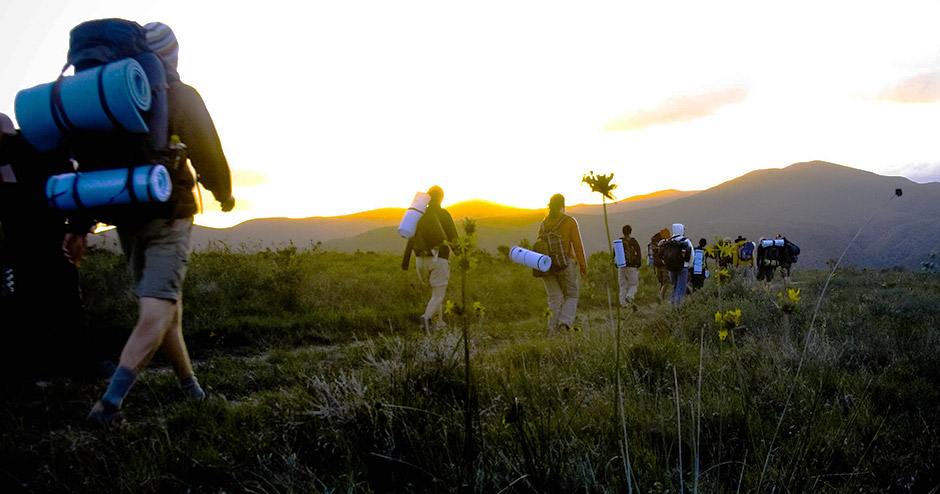The winners to the Reconnecting with Nature Contest have been awarded! As one of our judges said after reading the responses, “Phew, that was a difficult task … I’m grateful there were only a few (entries)!! A sense of connectedness is such a personal thing, and I found the insights fascinating.”
We are pleased to announce the winners of the Reconnecting with Nature Contest. Admittedly, we were not swamped with entries, but given the detail and quality of those we did receive, it may have been for the best! So we are grateful that those who did manage to send us their opinions – their time and efforts provide valuable added insight. It appears we are only really just scratching the surface on this critical topic.
The final decision went as follows:
QUESTION 1: Tie – winner’s prize split between entrants Sally Hofmeyr and John Roff.
QUESTION 2: Winner – Sally Hofmeyr.
Below you can read the winning responses for both the contest questions. This is followed by some text from the handbook Coyote’s Guide to Connecting with Nature (Young et al 2010) which provides added insight into what connecting with nature could mean and how we can assess it.
Sincere thanks to Alice Ashwell (EnviroEds), Bruce Dell (Wilderness Guide) and Mark Ogilvie (Cape Town Environmental Education Trust) who kindly helped judge the contest and provide helpful feedback.
Contest responses are as follows:
QUESTION 1: What do you understand by the phrase ‘(re)connecting with nature’?
a) What the experience of being (re)connected with nature looks/feels like (i.e. the what);
b) What you think people need to do to (re)connect with nature (i.e. the ‘how’);
(Re)connecting with nature is the process of letting nature back into our lives, of remembering that we humans are just as much a part of the entire community of life as the trees, grass, birds, bees, soil and water around us are. And in remembering this, it is the process of allowing ourselves to imagine what it might be like to be another type of being – to empathise with other members of the living community and to reawaken our sense of participation in the drama of life as a whole (as opposed to the life of humans only). It is a humbling but also enlivening, joyful, comforting, inspiring experience – as if finally coming home, after years of wandering. As far as I can see, the only way to do this is to slow down – or take time out anyway – to be quiet and spend time with non-human beings, allowing oneself to be as open as possible to the experience. Watch, listen, observe, feel, taste, touch – allow all experience in! Although spending time in wild places is probably the most powerful way to reconnect with nature, even just spending time in a garden or park or appreciating the birds and trees and other wild things in a suburban area can lead one back to reconnecting.
The phrase ‘(re)connecting with nature’ implies that there is something ‘out there’ called nature that conceptually or physically, needs (re)connecting with. This is unhelpful, since we (humanity) are as much an integral part of the planet’s ecological systems as any other part. So the initial question is flawed, because it assumes and thus perpetuates a human/nature divide, which is at the root of the problem we are trying to solve. That being said, I have spent the last 22 years trying to bridge the perceived gap between people and the rest of creation, and I believe there are few more important tasks. I like to think of my work as:
a) unveiling the connections and unity which are already there,
b) removing the blinkers to our understandings & perceptions of the richness of fully living on Earth,
c) and pointing people towards wonder.
This work includes:
1. Direct experiences of, in and with wild and beautiful places and creatures. These experiences may be mediated by a facilitator/teacher/guide, or they may be had without such a person. Both have their place.
2. Using the arts in their many forms – music, photography, painting, drama, poetry etc. as a platform for engaging with all of creation, thus facilitating and encouraging deep emotional connection between people and place, which is often more powerful than intellectual understanding by itself.
I have seen many different kinds of change in people during my time as an environmental educator, from apparently simple learning of facts and behavioural change to profound acknowledgement and realisation (almost revelation) of our place in the great scheme of things, the wonder and beauty of that, and the responsibility which accompanies it.
QUESTION 2: What criteria or indicators can we use to know if we are (re)connected with nature? (i.e. How do you think we can ‘measure’ or gauge your or anyone’s level of connectedness with nature?)
Gauging someone’s level of connectedness with nature is probably easier with yourself than with others, because I would say a big part of it is inside – not necessarily easy to see or measure. I would say that one factor that can be used is how much time they spend in nature; and if they are spending time outdoors and in natural areas, what are they doing? Are they zooming around in 4x4s, quad bikes or speed boats, or are they travelling quietly and slowly, taking time to listen, watch and absorb all that is around them? Do they notice the small things, or are they only out to see the big five, tick rare birds or catch the biggest fish? In other words, do they participate in nature, or try to dominate it? Another factor could be how much a person considers the rest of the community of life in their everyday thinking, activities, shopping, decision-making. Do they think about where their food comes from and how it was grown and processed, or is it simply a commodity to be purchased from a shop? Are they aware of the connections between all the aspects of our lives and the resources we use and the larger world? Does it bother them that natural areas are being destroyed to make way for development? Do they think about whether to poison the insects that bother them in their houses or to try and find another way to deal with the problem? Do they find inspiration in beautiful sunsets, majestic trees, tiny butterflies? Or do they spend their free time plugged into headphones / computer games / clubbing and getting drunk / etc.? None of these are absolutes – I am sure a dedicated fisherman or twitcher also experiences some level of connection with nature, and it is certainly possible that someone who enjoys playing computer games can also enjoy the outdoors – but these are probably all on a continuum of sorts – I would guess that the more connected a person is with nature, the less likely they are to pursue these sorts of activities, and the more likely they are to simply want to be outside and allow the natural world to be itself, and experience it for what it is on its own terms.
One individual and his affiliated organizations who have been very focused on the ‘nature connection’ question already for many years is Jon Young (USA). His stunning co-authored handbook Coyote’s Guide to Connecting with Nature provides some authentic experiential insight into what connecting with nature could really mean.
In relation to our contest’s questions, we provide an extract from the book which might provide some added insight:
Extract from Coyote’s Guide to Connecting with Nature (by Jon Young, Ellen Haas & Evan McGown, 2010)
What is reconnecting with nature?
“Simply put, we aim to create meaningful bonds between people and the rest of nature. When we say connection, we mean a familiarity, a sense of kinship, just as we all experience with our human family. The goal includes knowledge and skills, but ultimately relationships restore our bond to nature. Building this foundational connection with nature is like an relationship – it takes time to form really true bonds. Therefore, mentoring people in nature connection requires a long-term practice. Every outdoor event adds to the accumulated knowledge we strive for… But a longer-term and slower-growing mentoring relationship is far more effective for the powerful development of the individual’s awareness and connection to nature.” (Young et al 2010: pg. 30)
What criteria or indicators can we use for nature connection?
“Coyote Mentoring awakens people to be alive in their connection with the natural world. Our Field of Learning includes:
– Awakening Sensory Awareness;
– Cultivating Knowledge of Place; and
– Restoring the Bond between People & Nature.
This all involves primary learning, learning that uses our “mammalian brain”, the one underneath the neocortex, the one responsible for sensory awareness, emotion and relationship. Our foundational goal is to awaken and hone this native wilderness awareness, our birthright or “naturalist intelligence”. While we teach measurable skills… – such as scientific identification of flora & fauna, critical thinking, wildlife biology, tracking techniques, and the ability to glean field guides with pertinent information – we emphasize the healthy roots at the foundation of these measurable skills. These roots are qualities of being that lead to productive doing. For instance, the quality of Inquisitive Focus gives learners a powerful edge for life-long learning in all disciplines, academic, vocational, social, and spiritual. Standards for learning within the nature education movement must honor not only knowledge, but also the learners’ expressed happiness and energy as individuals, and the qualities of their relationships with their natural world. So, our criteria for success expressed by these Indicators of Awareness may seem more qualitative than quantitative….”Sometimes evaluation of students’ success is spiritual and intuitive; the most important learning can’t be measured in numbers.
The Indicators of Awareness are both symptoms of successful learning and learning goals. Here, we’ll organize them through association with the directions of the Natural Cycle [cardinal points]:
East: Common Sense ;
Southeast: Aliveness & Agility;
South: Inquisitive Focus;
Southwest: Caring & Tending;
West: Service to the Community;
Northwest: Awe & Reverence;
North: Self-Sufficiency;
Northeast: Quiet Mind.
These Indicators of Awareness offer the final layer of intention for you to be conscious of for guiding your people back into their most natural and powerful selves connected with their place.” (Young et al 2010: pg. 257-279)
Whilst the cash reward is now past, it is never too late to drop us a line at info@eyes4earth.org and let us know if you have any feedback on your own path in reconnecting with nature.




Be the first to share a comment